Adhesive bridge
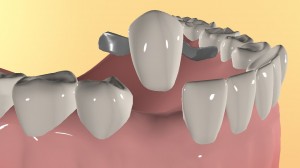
The adhesive bridge is a conventional dental bridge, which differs in the way it is attached to the abutment teeth.
The dentist may call the design: "adhesive", "Maryland." The essence of the names is the same - these are adhesive bridges.
The prosthetics technique using an adhesive bridge construction became possible after the advent of modern composite and fiberglass materials.
The use of an adhesive bridge is a gentle type of denture, because the adjacent teeth to which the structure is attached, there is no need to grind.
Adhesive bridge attachment methods
Fixing on the inside of the supporting teeth by gluing
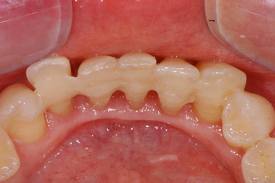
More modern adhesive prosthetics with bridges.
It involves gluing strips of durable and elastic material to the inner surface of the teeth: fiberglass and plastic, which glues real teeth with artificial ones, like when splinting.
A positive aspect of this method of prosthetics is reversibility.
The disadvantage may be the quality of the construction, which is manifested in the unreliability of the bridge, discomfort - due to the thickening of the abutment teeth and unaesthetics - the attachment is noticeable to others.
This method of fixation is not recommended for use on chewing teeth.
Beam mount
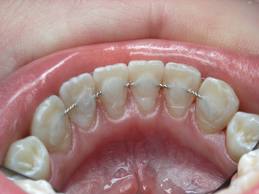
To increase the reliability of the adhesive bridge, a beam made of wire is used, which is fixed by the composite in the recesses on the abutment teeth.
Very often, the teeth used under abutment have large fillings, removing which the dentist receives ready-made cavities for attaching the bridge.
The beam structure is more durable, but it should not be used on chewing teeth either, since there is a very high risk of breakage.
As a result of prosthetics on wire beams, the risk of complications increases: pulpitis and periodontitis in the abutment teeth.
Splinting
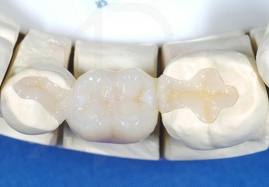
It is produced using fiberglass tape, which is laid in a narrow cavity made in the abutment teeth.
The method of adhesive prosthetics using fiberglass is - more modern. For fixing, harnesses and fiberglass bands are used. The technology is very similar to the previous way of fixing on wire beams.
A fiberglass beam is fixed on the abutment teeth, and an artificial tooth is created from the composite material on its base, directly in the patient's oral cavity.
This method of fixation to the abutment teeth is possible in the absence of caries and physical abnormalities of the abutment teeth.
Benefits of Prosthetics
- The use of adhesive technology is becoming increasingly popular, because with its help it is possible to restore individual tooth defects directly in the patient's oral cavity.
- Prosthetics with adhesive structures are possible in one visit to the dentist.
- Dentures are highly aesthetic constructions, in which there is no metal. This approach to prosthetics avoids the harmful effects of oxidizing alloys and the formation of galvanic pairs.
- Radical preparation of supporting teeth is excluded, including their depulpation, which greatly weakens the teeth.
- An artificial tooth is able to withstand high loads, due to its uniform distribution between the abutment teeth.
- With the appearance of chips of the structure, you can easily carry out its correction.
- Preservation of micromotion of supporting teeth, as the composite is capable of elastic deformations, like real teeth.
- Easy to remove if necessary.
- Low cost.
Indications
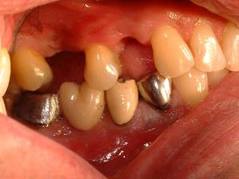
- Small defects in the dentition (absence of anterior teeth or premolars).
- Recommended for patients after myocardial infarction.
- Severe cardiovascular disease.
- Periodontal disease.
Prices
The prosthetics service with these designs has a wide range of prices. An adhesive bridge, the price of which depends on whether additional splinting is required, can cost from 6,000 to 10,000 rubles. If an increase in the number of supporting teeth is required, then the cost of the prosthesis increases in proportion to their number.
The cost of prosthetics may depend on the clinic, on the qualifications of the dentist, on the selected material for the manufacture of the structure.
| Type of construction | Price in rubles |
| Adhesive bridge (3 units) | 6000 |
| Bridge cast prosthesis (per unit) | 3500 |
| Ceramic metal bridge (per unit) | 6000 |
| Bridge ceramic prosthesis (per unit) | 16000 |
| Plastic bridge (per unit) | 1000 |
| Tabbed prosthesis on chromium - cobalt alloy (consisting of 3 units) | 10500 |
| Ceramic tabbed bridge prosthesis (3-piece prosthesis) | 44000 |
Adhesive bridge prosthesis before and after installation
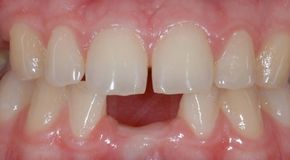 |
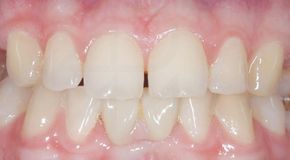 |
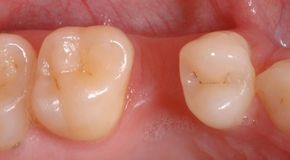 |
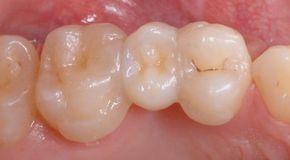 |
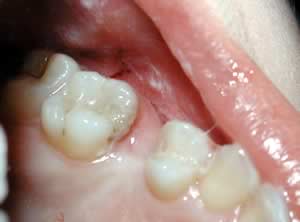 |
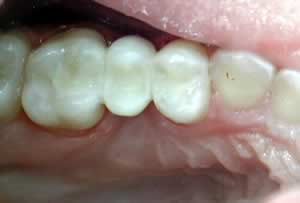 |
Video: “Adhesive bridge”